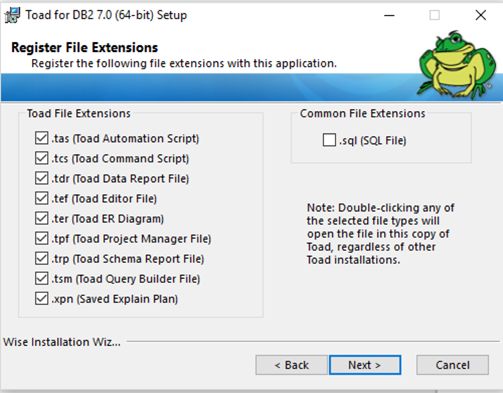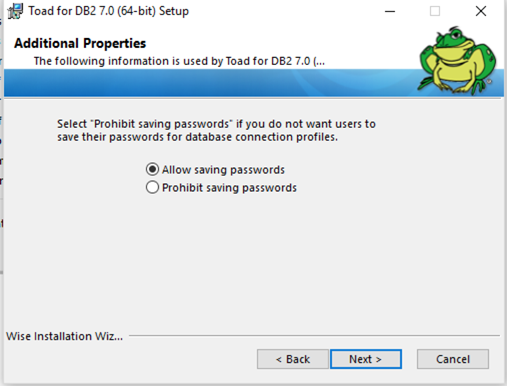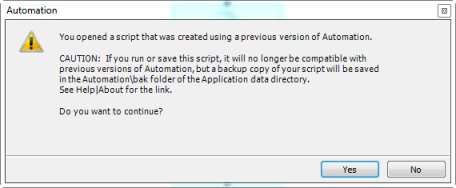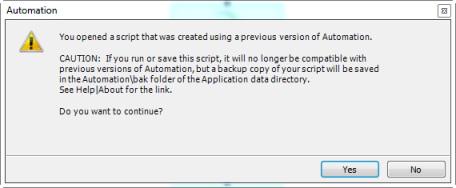1. System Requirements
| Expand | ||
|---|---|---|
| ||
1.1Supported PlatformsClient Requirements
The memory required may vary based on the following:
Required may vary based on the edition of Toad selected for installation.
|
| Expand | ||
|---|---|---|
| ||
1.2 Server Requirements
To be able to utilize a majority of Toad functionality, please grant VIEW DEFINITION on the SQL Azure databases you want to work with. |
| Expand | ||||||
|---|---|---|---|---|---|---|
| ||||||
1.23 User Requirements
The following exceptions exist for Power Users: A Power User cannot
A Power User can install Toad as long as this user belongs to the DB2ADMNS or DBUSERS group.
View file | | name | ToadDB2LUWAuthorizations
| View file | ||
|---|---|---|
|
.
Required user authorities or privileges for each DB2 database you want to monitor
2. Installation
| Expand | ||
|---|---|---|
| ||
2.1 Install TOAD forDB2There are several ways to find the installers : Finding Installers : Download product from the Website or Log in Support Portal Run the installer Click run as Administrator , Click Next SQL ServerToad for SQL Server license key determines the edition and will enable Toad for SQL Server functionality accordingly. In many cases, if functionality is disabled within Toad for SQL Server, you may not have an appropriate license to use it. When Toad is running, you can see which components are licensed by selecting Help | About. To install Toad
When installing Toad using Quest Software Installer on Windows 7 64-bit, Program 4. Select “ Toad File Extensions format” , Click Next 5. Check Allow saving passwords to prohibit users from saving their passwords in Toad. Click Next 6. Click Finish and Click Yes for restart the computer. |
| Expand | ||||||||
|---|---|---|---|---|---|---|---|---|
| ||||||||
2.2 Install Toad SQLOptimizer for DB2SQL Optimizer for IBM DB2 LUW lets you tune the SQL used in the DDL for triggers, views, or materialized query tables and the SQL included in packages. You can also tune the SQL on which you are working in the Editor. To Install SQL Optimizer for DB2 on a Windows machine :
| ||||||||
| Expand | ||||||||
| ||||||||
2.4 Specify Application Data Directory LocationThe default location cannot be modified from within the application. Toad provides two methods to change the default location: by using a Registry setting or by using a command switch in a Toad shortcut. Use the Registry setting method to change the application data directory from Roaming to Local. Use the command switch method to change the location to any new path. See the following table for default (Roaming) and resulting (Local) directory path.
To instruct Toad to always use the new directory path, add the command switch and the new directory path to a Toad desktop shortcut. Then use the desktop shortcut when opening Toad. To add the command switch, right-click the Toad shortcut and select Properties. directory path). Server SilentlySilent installation provides a convenient method for deploying Toad to multiple machines. With some customization, you can also deploy the license key and settings at the same time. Use a stand-alone installer to perform a silent install. Obtain your installer files at https://support.quest.com/
|
| Expand | ||
|---|---|---|
| ||
2.3 Install and Uninstall Toad Plug-InLaunch SsmsInstallation.exe from the Windows command prompt as administrator.
|
3. Licensing
| Expand | ||
|---|---|---|
| ||
3.1 Activate License Key- TOAD ForDB2SQL ServerTo enter your license keyactivate a purchased commercial license
License Your license key determines the edition of Toad (Pro, Xpert, etc.) and will enable the functionality |
| Expand | ||
|---|---|---|
| ||
3.32 Upgrade Toad
If you are upgrading from a previous version of Toad, you are prompted to migrate your settings the To migrate the settings again, remove or rename the current version's Application Data folder and The Diagnostic Server is no longer used by Toad for SQL Server. If the Diagnostic Server was installedwith a previous release of Toad for SQL Server then uninstall that program. Use Control Panel | Programs and Features | Uninstall or change a program and select to uninstall the Toad for SQL Server Diagnostic Server
3. Select No (and do not elect to save the script), to keep the script compatible with the previous
1. After upgrading Toad, and upon initial launch of the application, the Migrate Scheduled Tasks dialog opens. 2. Select the scheduled tasks (scheduled Automation scripts) to migrate to the new version of Toad. 3. Click OK to close the dialog. 4. Toad immediately prompts you for your Windows password. Enter your password to migrate thescheduled tasks. To migrate scheduling tasks using the Job Manager
Only currently-scheduled tasks (enabled or disabled) are listed in the Migrate Scheduled Toad immediately prompts you for your Windows password. Enter your password to migrate the Manually Edit Scheduling Tasks In the Job Manager (Tools | Administer | Job Manager), right-click a task and select Edit Task. run the script, in the Actions tab, change the folder name in the toad. exe path. |
4. Managing Licenses
| Expand | ||
|---|---|---|
| ||
4.1 Move License to another computerTo move the Toad application and license from one user to another user on a different computer.
|
| Expand | ||
|---|---|---|
| ||
4.2 Uninstall Toad forDB2SQL ServerIf you uninstall Toad, it may not uninstall completely. When you use Toad, you create new files such as SQL scripts, data output, or temp files, etc. The following types of files are not removed when you uninstall:
Can uninstall Toad for SQL Server by using the Windows install/uninstall programs feature. To uninstall Toad
|
Support Chanel : Support Portal






